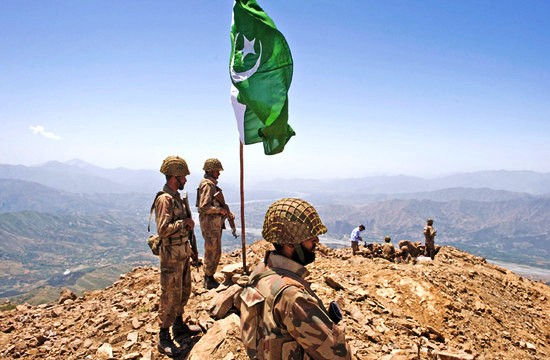
[stextbox id=”info”]Pakistan’s war against Taliban in its backyard has pitted it against its own people. IFTIKHAR GILANI, the first Kashmiri journalist to reach the troubletorn FATA, brings back first hand images of the frontier where superpowers are engaged in a big game.[/stextbox]
A stoic silence descended in the cabin, as the Russian build Mi-17 helicopter took flight from Pakistan Army’s 6th Aviation Squadron base in Islamabad.
An hour’s flight would take eight Indian journalists to Pakistan’s Pashtun tribal areas bordering Afghanistan. Victim of great power games, the region has mesmerized and romanticised the world for centuries. The bravery, quest for freedom and zest of inhabitants divided in innumerable tribes, led the dismemberment of Soviet Union, a super power of yore. There are no medals for them. But their stories are told besides campfires in the cold Hindu Kush Mountains. Ironically, another super power is now engaged in the region.
Our guide from Pakistan’s Inter-Services Public Relations (ISPR) Capt. Ali pointed out to our left announcing the copter was flying over Tarbela Dam. But hardly anyone was listening. Journalists were in trance, praying for clear weather and planning to use their life time opportunity to put a mark on history. For past three days we could not land at Swat and Askardo due to bad weather. After 31 years, Pakistan had officially invited a group of Indian journalists as part of media exchange programme and allowed them to proceed to Federally Administrated Tribal Areas (FATA), the scene of battle against Taliban.
Analysts back in Islamabad believed it was a big gamble.
The interior of the helicopter was cramped. There was nothing to call luxury. All the money had been spent on machinery – the armaments, speed and maneuverability – and none on comfort. The military copter is laced with missiles, bombs, small arms and cannons.
Pakistan’s Federally Administered Tribal Areas (FATA) are divided into seven political units or agencies—Bajaur, Mohmand, Khyber, Orakzai, Khurram, North Waziristan and South Waziristan, and four frontier regions – Peshawar, Kohat, Bannu and Dera Ismail Khan.
As the Army helicopter swept down in Khar, headquarters of Bajaur agency, northern most tip of Pakistan, rosy-cheeked children waved at us. It was the Nava pass, one of numerous passes connecting Bajaur with Kunar province of Afghanistan that Greek king Alexander used to march into India thousands of years ago.
Our guides asked us to shut cameras as we were entering the headquarters of Bajaur Scouts, a unit of Frontier Corps. A heavy posse of military personnel encircled the aircraft and led journalists straight to the operation room inside a fort, where Brigadier Zafrul haq and Colonel Mohammad Nauman Saeed were ensconced to give an operational briefing. A short distance from the briefing room, two artillery guns are dug into the soft soil, their barrels facing the mountains.
For a Kashmiri journalist, it was a familiar scene. Heavily barricaded roads, soldiers frisking people in nearby fields, bombed buildings, burnt up petrol pumps, but still people shopping and chatting around, as our convoy zoomed past markets and villages, under heavy security.
At Inayat Kila market a huge graffiti in a faint paint read “Hizbul Mujahideen and Jihad-e-Kashmir.” Another slogan by Jamiat-e-Ulma-e-Islam announces cutting hands of those pointing fingers at madrassas.
Eleven miles away from Khar is the village of Damadola, which has been target of frequent missile and drone attacks. Media reports suggested that sighting of Osama bin Laden and Ayman Al Zawahiri in this village lead to US missile strikes on January 13, 2006, killing 18 people.
It is said that the Taliban leader in Bajaur, Maulvi Faqir Mohammad, had hosted a dinner for al-Zawahiri, shortly before the US strike. On October 30, 2006, first US drone strike also hit the area killing 80 people, mostly children. Maulana Liaqat, the head of a local seminary was also killed in the attack.
Pakistan Army calls Damadola a militant nerve centre, where from insurgents launch attacks against the US and international forces across the border. Taliban had build an intricate network of 154 tunnels and caves in the nearby hills. An engineering marvel, it must have taken years to gouge out the rocks and debris. The end result was a multi-room apartment complex inside a mountain. Long tunnels connected bedrooms that were lined with old sleeping bags.















